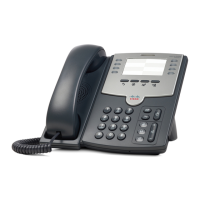Configuring Regional Parameters and Supplementary Services
Localizing Your IP Phone
Cisco Small Business SPA300 Series, SPA500 Series, and WIP310 IP Phone Administration Guide 190
7
To get better detection by the IVR, avoid inband and use OOB. This way, the DTMF
tone is reconstructed by the PSTN gateway or the remote endpoint, and the
quality is not subject to distortion from the audio codec. If you use OOB, use a
slightly longer DTMF Playback Length.
If you use inband, use a higher Inband DTMF boost.
NOTE On the Cisco SPA525G2, when using the Mobile Link line (through the Bluetooth-
enabled mobile phone), the local user can hear a double tone (echo) when pressing
digits (DTMF tones) while engaged on a call. This can happen with certain mobile
phones that have the option to play locally the local tone (which is also played by
the Cisco SPA525G2). This does not affect operation with interactive voice
response applications, as the tone is audible only on the local device. See the Cisco
support community at http://www.cisco.com/go/smallbizsupport for phone
compatibility information, and also consult the latest Cisco SPA525G2 release
notes, available at cisco.com.
Localizing Your IP Phone
The following table describes the localization parameters in the
Miscellaneous
section.
Field Description
Set Local Date
(mm/dd)
Enter the local date (
mm
represents the month and
dd
represents
the day). The year is optional and uses two or four digits. For
example,
May 1, 2008, can be entered as:
05/01 or 05/01/08 or 05/01/2008
Set Local Time
(HH/mm)
Enter the local time (
hh
represents hours and
mm
represents
minutes). Seconds are optional.
Time Zone Selects the number of hours to add to GMT to generate the local
time for caller ID generation. Choices are GMT-12:00, GMT-
11:00,…, GMT, GMT+01:00, GMT+02:00, …, GMT+13:00.
Defaults to GMT-08:00.
Time Offset (HH/
mm)
This specifies the offset from GMT to use for the local system
time.

